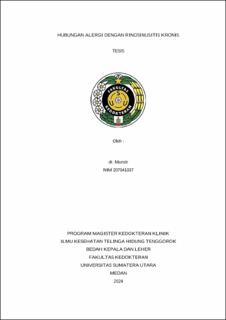| dc.contributor.advisor | Munir, Delfitri | |
| dc.contributor.advisor | Rambe, Andrina Yunita Murni | |
| dc.contributor.author | Munzir, Munzir | |
| dc.date.accessioned | 2025-04-23T06:33:43Z | |
| dc.date.available | 2025-04-23T06:33:43Z | |
| dc.date.issued | 2024 | |
| dc.identifier.citation | Harvard | en_US |
| dc.identifier.uri | https://repositori.usu.ac.id/handle/123456789/103318 | |
| dc.description.abstract | Introduction : The role of allergy in chronic rhinosinusitis is still controversial. Many studies have shown a high prevalence of atopy in chronic rhinosinusitis patients with a possible role of allergy in the pathophysiology of chronic rhinosinusitis. Chronic rhinosinusitis (CRS) is characterized by an increase in the number of eosinophils in the nasal mucosa and sinuses. Allergy, especially IgE-mediated inflammatory processes, are generally considered as triggering factors in the development of chronic rhinosinusitis or comorbidities/associated factors for the spread of chronic rhinosinusitis. Methods : This research is an analytical study with cross-sectional approach. 30 patients with symptoms of runny/blocked nose were examined. Allergy skin prick tes, has been examined to categorize allergic and non-allergic patients. Total serum IgE and total eosinophil examination from blood were then categorized as increased and normal. The criteria for chronic rhinosinusitis are complaints of runny/blocked nose and facial pain and/or decreased sense of smell. Results : Thirty patients (19 females and 11 males) aged 17 to 77 years were examined in this study. 19 patients were confirmed to have rhinosinusitis and 11 rhinitis. The results of the analysis using the Chi Square test showed that there was no significant relationship between allergy, IgE, eosinophils, and chronic rhinosinusitis (p>0.05). The Mann Whitney test showed that there was a significant difference in Lund Kennedy scores between CRS patients and non-CRS patients (p<0.001). Conclusion : There was no significant relationship between allergy, IgE, eosinophils with chronic rhinosinusitis. Lund Kennedy score was found to be higher in patients with chronic rhinosinusitis. | en_US |
| dc.language.iso | id | en_US |
| dc.publisher | Universitas Sumatera Utara | en_US |
| dc.subject | CRS | en_US |
| dc.subject | Allergy | en_US |
| dc.subject | Eosinophil | en_US |
| dc.subject | IgE | en_US |
| dc.subject | Skin Prick Test | en_US |
| dc.subject | Lund Kennedy Score | en_US |
| dc.title | Hubungan Alergi Dengan Rinosinusitis Kronis | en_US |
| dc.title.alternative | The Relationship Between Allergy and Chronic Rhinosinusitis | en_US |
| dc.type | Thesis | en_US |
| dc.identifier.nim | NIM207041037 | |
| dc.identifier.nidn | NIDN0026015401 | |
| dc.identifier.nidn | NIDN0022067101 | |
| dc.identifier.kodeprodi | KODEPRODI11103#Ilmu Kedokteran Klinis | |
| dc.description.pages | 122 Pages | en_US |
| dc.description.type | Tesis Magister | en_US |
| dc.subject.sdgs | SDGs 4. Quality Education | en_US |


